Sikorsky Product History
Sikorsky S-51
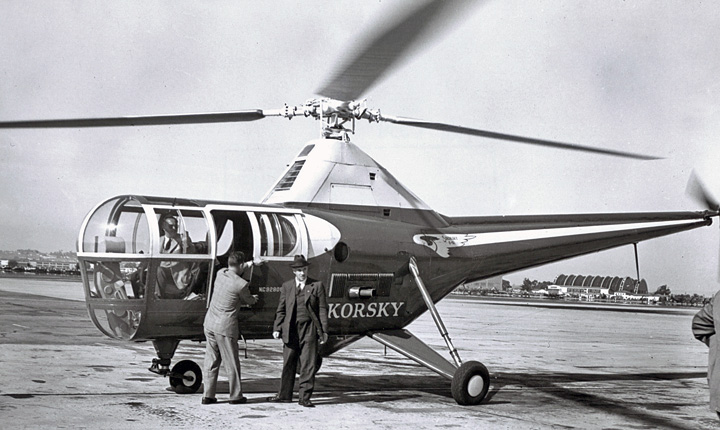
Background
The Sikorsky S-51 helicopter was a company funded commercial version of the S-48/R-5 helicopter. World War II had ended and the market for sales of Military helicopters did not look promising. The S-51 helicopters featured a 48 foot 3 bladed fully articulated main rotor and a 3 bladed tail rotor powered by the reliable Pratt and Whitney 450 hp R985-AN5 radial engine. The S-51 had the pilot forward in the cockpit with a 3 place bench seat across the back of the cabin. The first commercial customer was Los Angeles Helicopter Airway who
purchased five S-51 helicopters and established a passenger and U.S. Air Mail Service in the Los Angeles Basin area. The next customer was the U.S. Navy who purchased four S-51 (HO3S-1) helicopters to support Operation Highjump, Antarctic operations

Los Angeles Airways – First regular U.S. Air Mail service by helicopter
The U.S. Post Office Department awarded a contract (AM-84) to Los Angeles Airways to fly air mail services from LAX airport to three segments adjacent to Los Angeles. Operations commenced on October 1, 1947 when a small fleet of five S-51’s flew to the downtown post office, the San Fernando Valley, San Bernardino and Newport Beach. This proved that use of helicopters was feasible for the transport of mail and later, passengers. Service was incrementally increased so that by January 8, 1949 it had expanded to cover forty-four LA suburbs and totaled about 356 miles. Of special note were the shuttle flights that made 42 trips per day in each direction between LAX airport and the Terminal Annex Post Office building with the helicopters landing on and taking off from the Post Office roof.
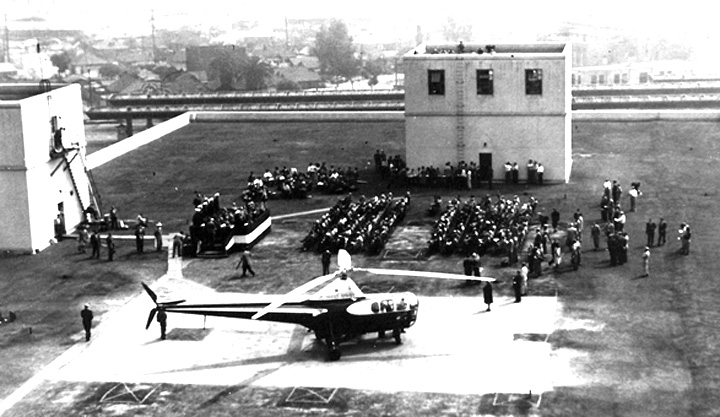
LAA Air Mail service with the S-51 helicopter continued until 1954 when the S-55 replaced the S-51 helicopters. To improve service reliability the LAA S-51 helicopters were equipped for night flying (Landing, Position, and Navigation lights). Later the LAA helicopters were equipped for instrument flying to allow take off and landings in the early morning fog common in the Los Angeles basin. The LAA S-51 helicopters were the first helicopter certified for flying in instrument conditions. LAA pilots were permitted to “go on instruments” for periods not exceeding 15 minutes. This CAA authority applied only to LAA S-51 helicopters.
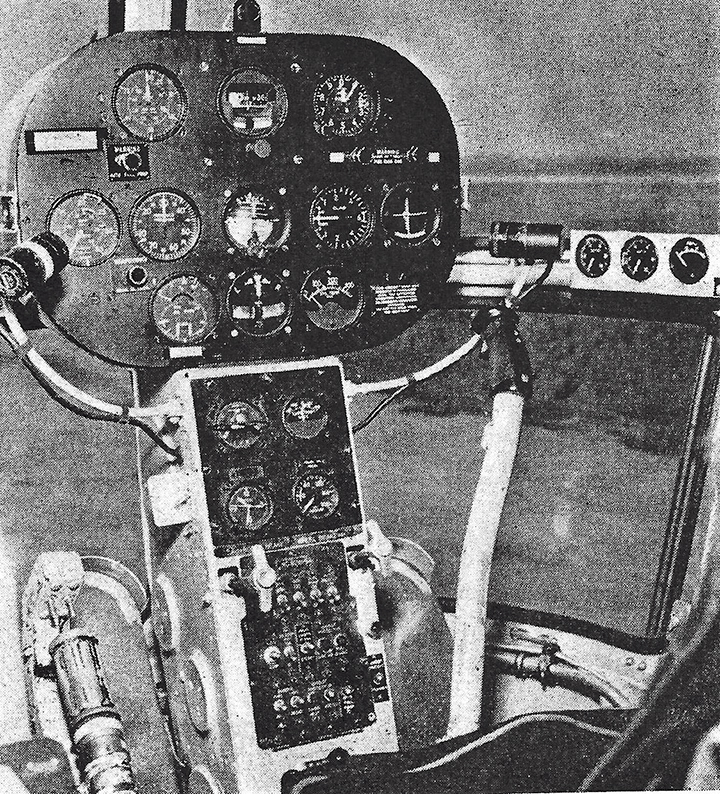
To prove to the Navy the usefulness of the helicopter, Sikorsky sent an S-51 helicopter in 1947 to sea with Task Force 2 with 2 pilots and 2 crew chiefs. The first military rescue by a helicopter was accomplished on February 9, 1947 by a Sikorsky S-51 helicopter flown by Sikorsky chief pilot Jimmy Viner assisted by LT Joe Rullo, USN. The S-51 Demonstrator was embarked on the USS Franklin D. Roosevelt and flying as a “Plane Guard” while the carrier was recovering aircraft. An SB2C Helldiver had an engine failure and crashed into the water. Jimmy Viner and his helicopter were immediately on scene and recovered LT Robert Shields and his Radioman. The complete story of this rescue is available in the First Naval Rescue historical essay.
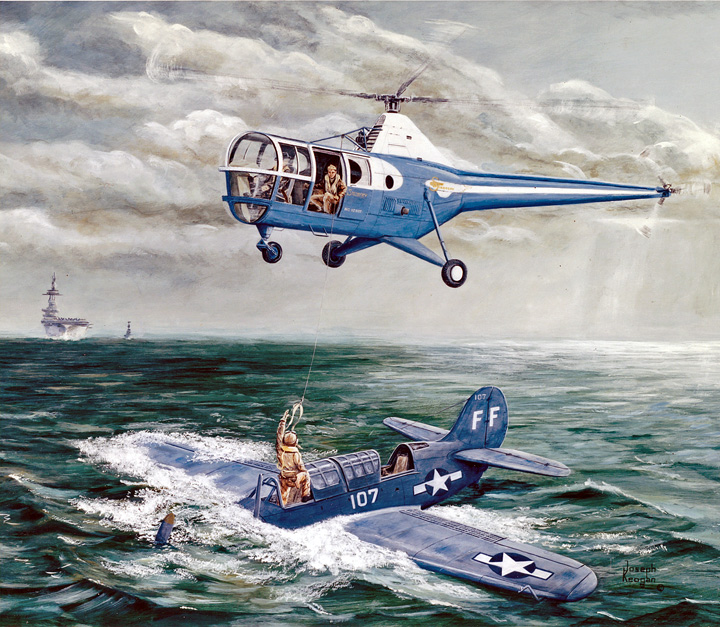
In 1948, Texas Senatorial candidate Lyndon Johnson leased a company owned S-51, N92805, with crew (Pilot Jim Chudars and Crew Chief Harry Nachlin) The S-51 flew the future Senator and President to 18 cities and towns as he campaigned for the U.S. Senate.
Military Helicopter Developments – The S-51 Goes to War
Marines HMX-1, the USMC operational test and development squadron was formed on December 1, 1947. Their mission was to develop uses for the helicopter by the Marines. During an amphibious operation with forces from nearby Camp Lejeune five HO3S-1 helicopters transported 66 troops from ship to shore avoiding the dangers of a beach landing.
The Korean War erupted on June 25, 1950 and pilots and maintenance personnel from HMX-1 were assigned to VMO-6 which deployed to Korea with four HO3S-1 helicopters. In Korea the helicopters were used by the Marines as an Observation/Liaison role with SAR as a constant alternative mission. Senior Military personnel were provided transportation to units in their command and battlefield real time observation. Diversions for rescues were frequent during these missions. During late 1950 23 air crewmen were rescued from behind enemy lines by VMO-6 helicopters.
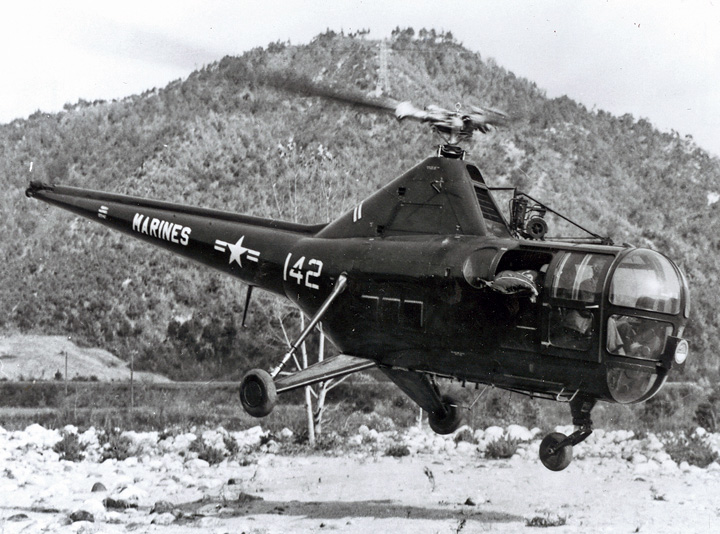
The U.S. Navy arrived in Korea with HO3S-1 helicopters from Helicopter Utility Squadrons HU-1 and HU-2 assigned to Aircraft Carriers and a few large warships. The Navy used their helicopters to pluck fliers out of the sea and perform inland rescues when called upon. They also carried supplies and mail from ship to ship. Later they were used to provide targeting information for naval guns and locating sea mines for demolition.
In the 1955 movie Bridges At Toko-Ri, Two Frozen Mackerel-Chopper pilot Chief Forney, an Enlisted Pilot (AP), (Mickey Rooney) and pal Nestor (Earl Holliman) rescue ditched flier Brubaker (William Holden), to the great relief of the Admiral (Fredric March). Note in the movie that the HO3S-1 helicopter is so quiet that the pilot can hold a conversation with the rescued pilot hanging from the hoist.
The following silent clip is a real rescue during the Korean War. The clip is a HO3S-1 of HU-1 performing a rescue in Wonsan harbor in 1951.
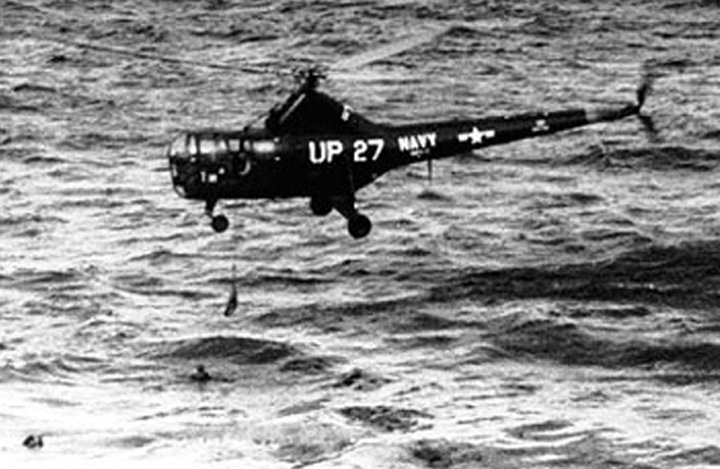
The USAF 3rd ARS had nine H-5 helicopters in Japan when the war broke out. They were deployed to Korean and by late 1950 had rescued 73 air crewmen from behind enemy lines. The Air Force H-5 helicopters also transported wounded to MASH (Mobile Army Surgical Hospital) units and also transferred seriously wounded from MASH units to large military hospitals and hospital ships off shore.
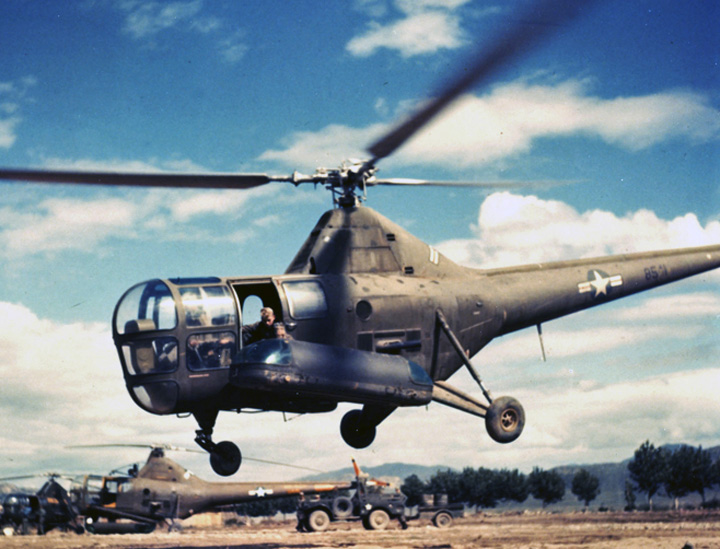
S-51 Development Timeline
First Flight
First Helicopter in Antarctica
License Agreement with Westland Aircraft
First Naval Rescue
CAA Type Certification
First Flight of the WS-51
Unofficial Record Set
Operations Begin in Korea
Configuration Features
The Sikorsky S-51 fuselage was built in 3 sections: an aluminum framed cabin with Plexiglas windows and the pilot forward and seating for 3 passengers aft; a steel frame center section was covered with easily removable panels, and the tail cone was a monocoque design with magnesium skins.
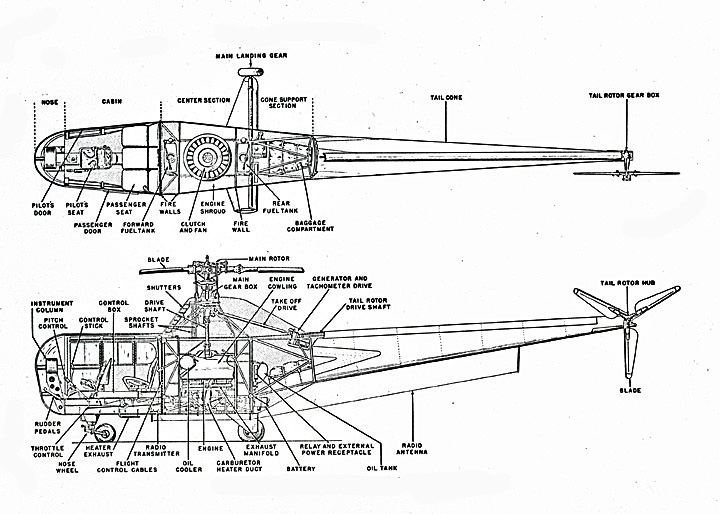
The S-51 helicopters were modified to several different configurations during their years of service. In addition to the civilian S-51 models, they were operated by the U.S Navy/USMC as HO3S-1, the USAF as H-5F, H-5G, and H-5H, and the USCG as the HO3S-1G.
Main Rotor Assembly
A 3 bladed fully articulated main rotor head was installed on the S-51 helicopter. The rotor diameter was 48 feet on helicopters and 49 feet on helicopters with all metal blades and controlled by a mechanical control system and a bungee trim system to reduce pilot fatigue. A rotor flapping restrainer was optional equipment which allowed rotor engagement in higher wind conditions.
A hydraulic servo system eliminated the bungee trim system in late production helicopters (H-5H) and was offered as a retrofit kit for earlier models. Hydraulic power for the servo was provided by a hydraulic pump belt driven by the tail rotor driveshaft.
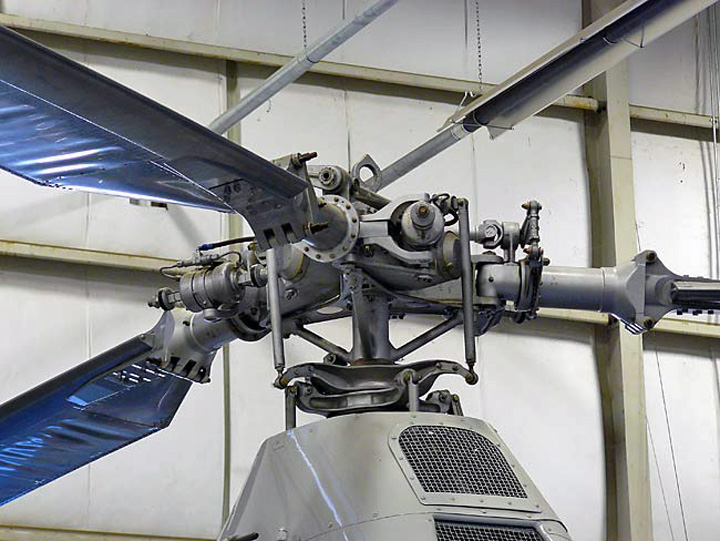
U.S. Coast Guard Commander Frank Erickson, chief helicopter development engineer, developed an airfoil stabilizer that mounted below the main rotor which allowed hands off flying. Cdr. Erickson stated that he flew the HO3S-1G helicopter for over an hour in still air without touching the controls. This feature was never adopted by Sikorsky Aircraft.
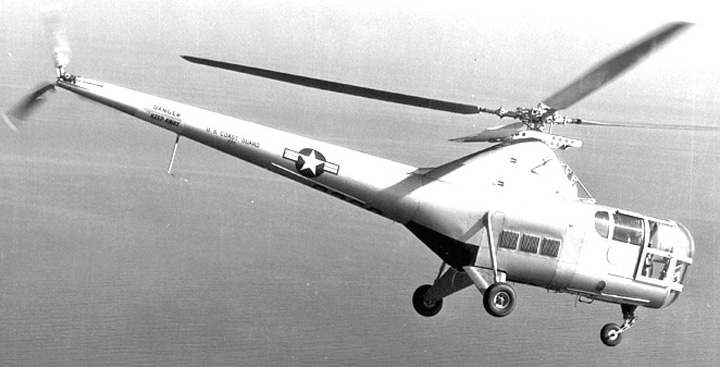
Tail Rotor Assembly
A 3 bladed 8’ 5’ diameter tail rotor with laminated wood blades was installed on the S-51 helicopter. A 2 bladed 8’ 9” diameter tail rotor with all metal blades was installed on late model S-51 (H-5H) helicopters and was offered as a retrofit kit on earlier models.
Engine
A Pratt and Whitney Wasp Jr. 450 hp R-985 AN-5 or AN-7 engine was installed horizontally under the center section of the helicopter with a cooling fan/flywheel above.
Main Rotor Blades
The main rotor blades were constructed with metal spars, plywood ribs, plywood pockets with the entire blade covered with 2 layers of fabric. A NACA 0012 airfoil was used. All metal blades were provided in later models during production (H-5H) and offered as retrofit kits for earlier models.
General Arrangement Drawing
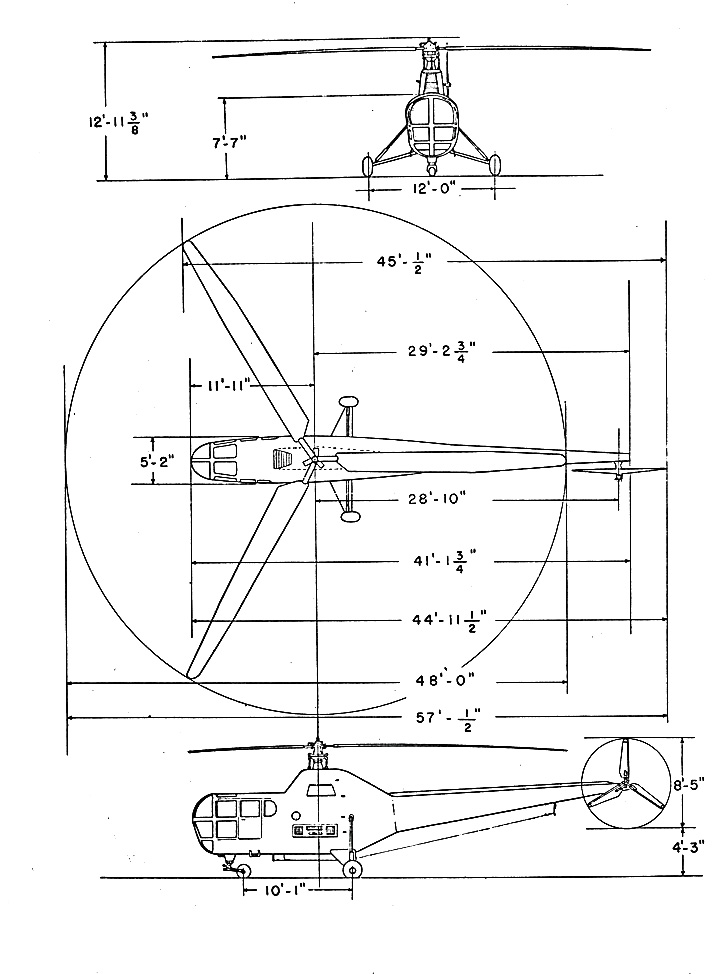
Mission Systems
The S-51 military helicopters were equipped with a rescue hoist and an auxiliary fuel tank. External litters could be attached on both sides of the fuselage. The litters were angled so the patient was level during forward flight and had the covers has windows to prevent claustrophobia.
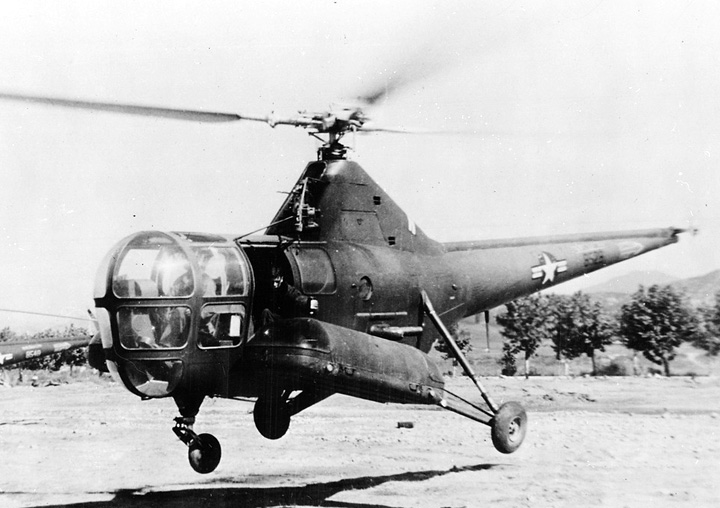
Emergency Floatation
The USCG developed an emergency floatation system with inflatable floats around the landing gear that inflated within 30 seconds in an emergency.
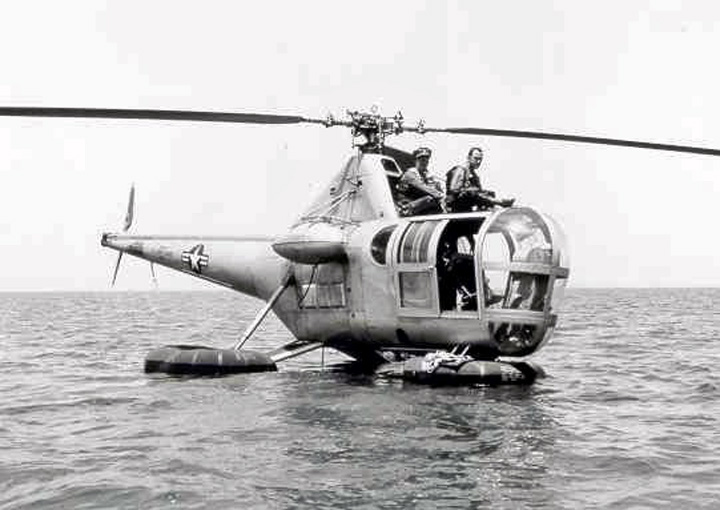
General Characteristics and Performance
Performance Standard Day at Sea Level | |
|---|---|
Maximum Speed (Vne) | 107 kts / 198 km/hr
|
Range | 275 miles / 442.6km |
Service Ceiling | 14,800 ft / 4,511 m
|
Rate of Climb | 2,000 ft/min / 10.1 m/s |
Absolute Hover Ceiling | 3,000 ft / 914.4 m
|
Weights | |
|---|---|
Maximum Takeoff Gross Weight | 5,500 lbs / 2,494.8 kg
|
Weight Empty | 4,050 lbs / 1,837 kg
|
Maximum Fuel Load | 100 gal / 378.5 ltr
|
Useful Load | 1,450 lbs / 657.7 kg
|
General Data | |
|---|---|
Crew Seating Capacity | 1 |
Seating Capacity | 3 passengers |
Powerplant Ratings Standard Day at Sea Level | |
|---|---|
Pratt and Whitney R985 AN-5 | 450 hp / 335 kw |
Aircraft Dimensions | |
|---|---|
Main Rotor Diameter (Blade Tip Circle) | 48’ 0” / 14.63 m (49′ with all-metal blades) |
Tail rotor diameter (blade tip circle) | 8’ 5” / 2.44 m (8’ 9” with 2 metal blades) |
Fuselage Length | 41’ 7.5″ / 12.5m
|
Length Overall (Including Rotors) | 57’ 1″ / 17.4 m
|
Height Overall | 13’ 1.5” / 4 m |
Main Landing Gear Tread | 12′ 0″ / 3.7 m |
Production History
Sikorsky Aircraft S-51 production consisted of 220 helicopters. Westland built an additional 159 helicopters under license:
- 55 Commercial S-51
- 90 U.S. Navy/ Marine HO3S-1
- 9 U.S. Coast Guard HO3S-1G
- 11 USAF R/H-5F 1947
- 39 USAF H-5G 1948
- 16 USAF H-5H, the Cadillac of the S-51 helicopters with bubbles on the fuselage that allowed 2 litters plus a medic in the cabin and 1 litter in the aft compartment. It also had all metal main and tail rotor blades. The flight controls were hydraulically boosted eliminating vibration feedback through the flight controls. The landing gear included wheels or amphibious floats and a droppable auxiliary fuel tank could be carried under the mid fuselage.
After the Korean War military surplus S-51 helicopter were sold on the open market. Sikorsky Aircraft purchased some of these helicopters, updated and overhauled them and sold them commercially as S-51 helicopters with zero time since overhaul. They also sold kits and provided instructions for converting military S-51 helicopters to meet CAA (FAA) Certification requirements.
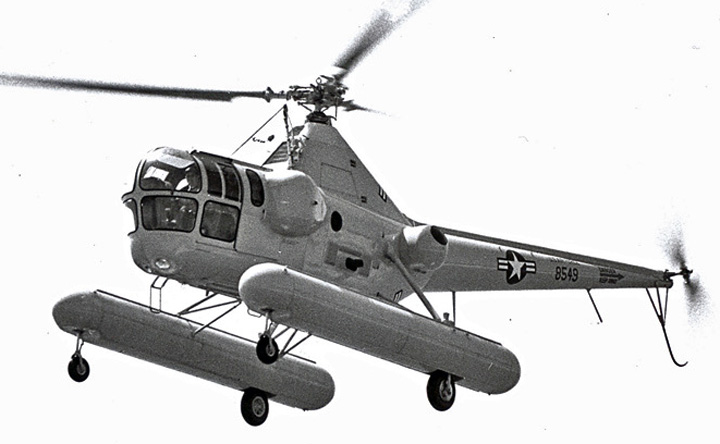
Related Models
Westland License
Westland Helicopters Ltd. of Yeovil, England obtained a License to build the Sikorsky S-51 helicopter. Westland produced 159 helicopters in various configurations:
- WS-51 The Westland built prototype
- WS-51Mk 1A. Civil transport helicopter powered by a 520 hp (388 kW) Alvis-Leonides 521/1 radial piston engine
WS-51 Mk 1B. Civil transport helicopter powered by a 450 hp (336 kW) Pratt & Whitney R-985 Wasp Junior B4 radial piston engine - Dragonfly HR.1, HR-3 (Metal Blades), HR-5.Air-sea search and rescue helicopter for the Royal Navy Fleet Air Arm (FAA) powered by a 540 hp (400 kW) Alvis 50 radial piston engine.
- Dragonfly HC.2, HC-4 (Metal Blades). Casualty evacuation helicopter for the Royal Air Force similar to the commercial Mark 1A.
A technical issue with installing the Alvis-Leonides engine was that it turned in the opposite direction from the Pratt-Whitney Wasp Jr. engine. This was solved by adding reverse gear assembly in the Engine Fan/Flywheel assembly.
Westland Helicopters sold WS-51 helicopters to many foreign countries both commercially and to the military. These included Belgium, Egypt, France, Iraq, Italy Ceylon, Japan, Thailand, and Yugoslavia
Westland Widgeon
Using private funding, Westland developed a highly modified WS-51 helicopter with dual control side-by-side cockpit seating. Westland improved the c.g limits of the helicopter by incorporating the offset flapping hinge rotor head from the S-55 (Whirlwind) helicopter. This modification required using the upper gearbox section and rotor mast from the S-55. The first flight was August 23, 1955. Westland’s plan was to sell the Widgeon to the British Armed Forces as a modification to their existing Dragonfly fleets. This did not occur since the more capable S-55 (Whirlwind) was already in production. A few Widgeons were sold (15) but production was halted.
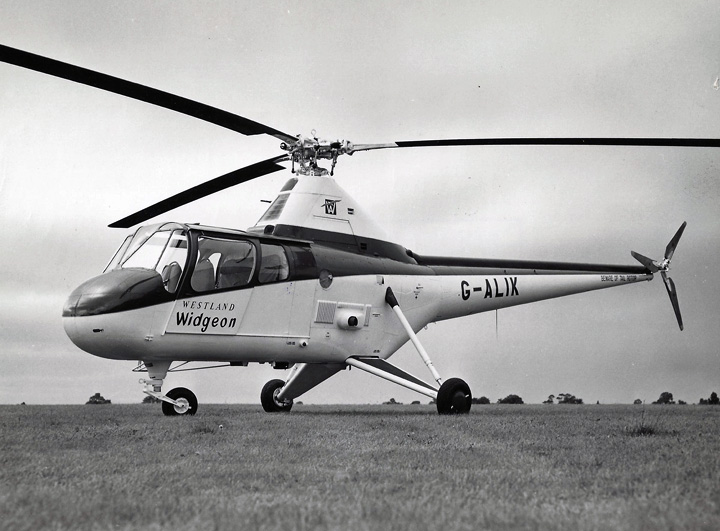
Additional Information
A restored S-51 helicopter is on display at the New England Air Museum, Windsor Locks, Connecticut. The model on display, Serial Number 5119, was delivered to the RCAF in 1947. It later was used as a commercial helicopter. This helicopter was completely restored by a volunteer group of retirees from Sikorsky Aircraft and painted in the colors of a Sikorsky executive transport demonstrator.
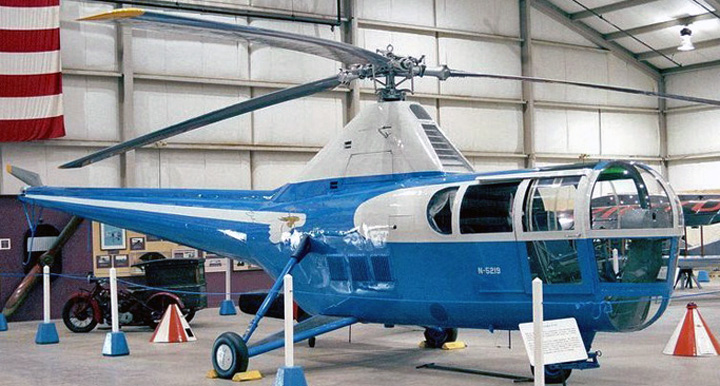
- by Vinny Devine
Related Articles
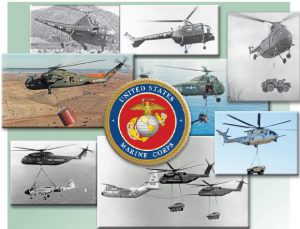
Sikorsky Builds Marine Corps Heavy Lift
The evolution of the Marine Corps’ CH-53K King Stallion heavy lift helicopter beginning with the Sikorsky S-56 in 1953.
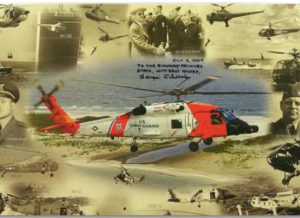
Sikorsky Serves the Coast Guard
A flight demonstration of Igor Sikorsky’s VS-300A helicopter at Bridgeport, Connecticut in April 1942 started an air-sea rescue revolution in the U.S. Coast Guard.
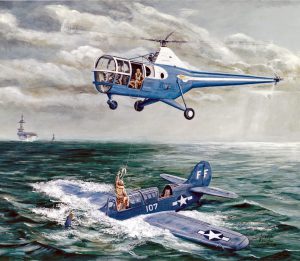
The World’s First Helicopter Naval Rescue
The first Naval helicopter rescue, performed in a S-51 by Sikorsky’s D.D. “Jimmy” Viner, proved the helicopter’s usefulness for Naval search and rescue missions.

Sikorsky Helicopters in U.S. Air Force Rescue Squadrons
The HH-60W Combat Rescue Helicopter is the latest in the life-saving line of Sikorsky helicopters made for U.S. Air Force Rescue Squadrons. The Whiskey will round out a century of vertical flight rescue heroism.
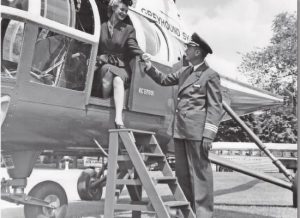
Sikorsky Helicopters in Airline Service
Early in the evolution of Sikorsky helicopters, Igor Sikorsky and his team envisioned scheduled passenger flights serving major cities.
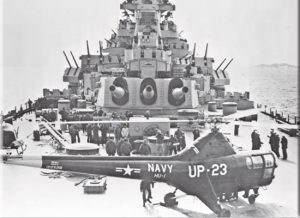
Sikorsky Helicopters Came of Age in the Korean War
Prior to the Korean War, the U.S. armed forces had few helicopters and little combat helicopter doctrine. The Korean conflict drove rapid combat helicopter development.

U.S. Coast Guard and Sikorsky Celebrate Significant Events
The United States Coast Guard and Sikorsky Aircraft celebrated two significant events in 2016. One century of United States Coast Guard aviation and the 127th birthday of Igor Sikorsky.
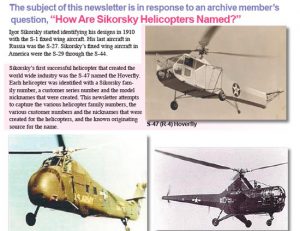
How Sikorsky Helicopters Are Named
The subject of this newsletter is in response to an archive member’s question, “How Are Sikorsky Helicopters Named?”
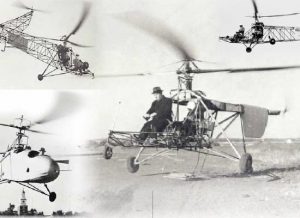
75th Anniversary of the S-46 (VS-300)
During this period, Sikorsky Aircraft designed, developed, and produced the S-47 (R-4), S-48 (S-5), S-49 (R-6), S-51, S-52, and S-55 helicopters.
